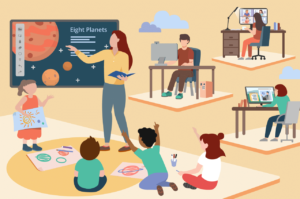Gerstien’s metaphor completely relates to my experience at Byju’s where we as an educator leverages the technology and digital tools to create more interactive and child- centered learning path for the individuals. The concept of Education 3.0 resonates how education is evolving from traditional setting to more interactive, technology driven and personalized model similar to the transformation from web 1.0 to 3.0. I believe Gerstien’ s metaphor calls for an urgent need to reflect on our practices in education and should work to bridge the digital divide and make advanced tools easily accessible  and approachable for every student and teacher regardless of their backgrounds.
and approachable for every student and teacher regardless of their backgrounds.
I think the shift to Web 3.0 has reshaped education and brought unique perspectives. With Education 3.0, the role of students have changed from mere passive learners to creators and contributors which results in breaking all the traditional boundaries and concreting their own lifelong learning path. However, with the increase in autonomy, there comes new demands on students as well as on teachers that needs to be addressed. Firstly, equality in technology or internet access for all students is difficult to achieve which could result in educational disparities among the students who belong to rural areas. Secondly, sometimes the complex nature of Web 3.0 overwhelms the students and they have not developed strong time management, focus, or motivation skills which could further create pressure on them.
This adaptation to Education 3.0 benefits particularly those students and teachers who have the expertise in using digital tools and navigating technology. On the other hand, the students who really struggle with the technology or have limited access to the digital tools feel disadvantaged by the shift to Education 3.0. In the BYJU’S we regularly saw many children who did not have an understanding learning environment at home face challenges in persisting with their peers.
Similarly for the teachers, who are not flexible and not tech-savvy with digital teaching may struggle to adjust and lead to create gaps in student engagement and support. However, the teachers who are open to integrate the technology into their teaching methods will create a dynamic learning environment.

Well said, Aatif! Your insights on Education 3.0 and its impact on both students and teachers are relevant. I love how you connected Gerstein’s metaphor to your experience at Byju’s, where leveraging technology for interactive and child-centered learning is a priority.The challenges you mention around tech accessibility and the digital divide are crucial, as these can create disparities for students in rural or under-resourced areas. It’s inspiring to see how open-minded and tech-savvy teachers, like those at Byju’s, can help bridge this gap and foster a dynamic learning environment.
Hi Mohammad,
You have certainly highly some keys areas that I think are too often overlooked. Yes technology is evolving which is evident through the evolvement of the Web series, but, the reality is there are some students who still do not have access to devices on internet. Back home, there are some deep rural area that are prone to flooding and with the least bit of rain they have no internet or electricity for week, sometimes months. It does result in disparity in education and a traditional approach in teaching is sometimes their only option. You also mentioned the possible resistance of teachers who are not tech savvy, from my experience, these digital tools were pushed on these teachers with little or no training on how to use them. Integrating technology then feels more of a challenge than a solution to these teachers. It was refreshing reading your unbiased perspective and I am looking forward to reading more your blogs.
Hi Mohammad
Thanks for this beautiful write up. Your expression of the need for every student and teachers to have access to these digital tools is totally correct. But I sometimes wonder if this can be possible especially in Global South countries. Many countries in the Global South are still largely dependent on Education 1.0 and Web 1.0 with the exception of very few who have migrated to Web 2. 0. However, even though some have migrated to Web 2.0 most of their teaching practices are still aligned to Education 1.0. I can say that the obstacles mentioned in relation to equitable access to technology is real and its plays a big factor on how schools transition acoss the various Web and Education Era.